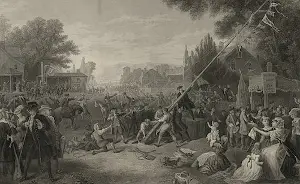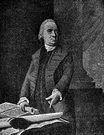The Sons of Liberty
The Sons of Liberty was an unofficial, often underground protest group in colonial America. Begun in New England, the group soon had members in all 13 Colonies. Its most famous act was the Boston Tea Party. Colonial opposition to new taxes that the British Parliament had passed in an attempt to help pay for the French and Indian War debt reached a fever pitch with the passage of the Stamp Act in 1765. 
It was called the Stamp Act because it required a stamp to be put on all kinds of paper used by the colonists. They did use a lot of paper in those days. Documents of court proceedings and land and business sales were printed on paper, as were newspapers, pamphlets, and even playing cards. Colonists certainly were not happy about paying a paper tax. The reaction was loud and sometimes violent. People gathered in the streets and in taverns to protest. Instigating many of these actions were the Sons of Liberty, an underground organization that began in Boston and New York and eventually claimed members in all of the colonies. 
The Sons of Liberty had its roots in the Loyal Nine, a gathering of Boston businessmen who gathered in the wake of the March announcement 1765 of the Stamp Act in order to figure out a way to prevent it from being enacted. The members of the Loyal Nine were braziers Steven Cleverly and John Smith, distillers John Avery and Thomas Chase, jewelers Henry Bass and George Trott, painter Thomas Crafts, printer Benjamin Edes, and ship's captain Joseph Field. Edes was printer of the Boston Gazette, and the Loyal Nine had their initial meeting at this office. The group found a willing participant in civil disobedience in shoemaker Ebenezer Mackintosh, who agreed to be the leader of whatever large group of people was needed for any form of public protest. The first such action took place in August 1765, when a group of men gathered under a large elm tree in Hanover Square, a tree that came to be known as the Liberty Tree. Mackintosh led later actions by the Sons of Liberty. Members of the Loyal Nine were thought to have participated in such events but took pains to conceal their identities. 
One man who burned with opposition to the latest actions of Parliament was Samuel Adams, who is thought to have been the founder of the Sons of Liberty. He met with the Loyal Nine several times. The group did not keep detailed records of its meetings or its members, who were from all walks of life and all economic and social classes. Some of America's most well-known figures were members, including John Adams, Benedict Arnold, John Hancock, Patrick Henry, Paul Revere, Benjamin Rush, Haym Solomon, and Oliver Wolcott. 
The group had its own flag, a series of nine vertical stripes (five red and four white), and its own symbol for a meeting place, the Liberty Tree. The first one was in Boston; members of the group would make a habit of erecting similar trees in other locations, daring British authorities to remove them. (This often happened.) The name of the group the Sons of Liberty actually came from a member of Parliament. Irishman Sir Isaac Barré was giving a speech in Parliament in February 1765, during a debate over the Stamp Act, when he said, in part: "They grew by your neglect of them. As soon as you began to care about them, that care was exercised in sending persons to rule over them, in one department and another… sent to spy out their liberty, to misrepresent their actions and to prey upon them; men whose behaviour on many occasions has caused the blood of these sons of liberty to recoil within them ..." Next page > Actions and Consequences > Page 1, 2 |
|
Social Studies for Kids
copyright 2002–2024
David White




